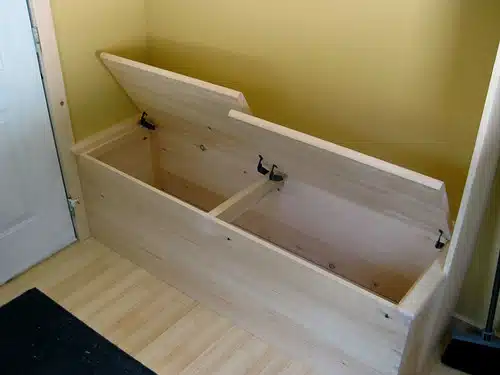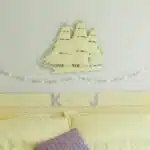Creating a mudroom bench is an excellent way to organize your entryway and keep it clutter-free. A mudroom bench can be a stylish piece of furniture that enhances the look of your home, while also providing a functional solution to store shoes, coats, and other items. In this article, we will explore the essential steps to build your own DIY mudroom bench.
Building a DIY mudroom bench requires some basic woodworking skills and tools. However, with the right materials and guidance, anyone can successfully create their own custom-built mudroom bench. This project is perfect for those who want to add a personal touch to their home decor while also benefiting from practical storage solutions. By following our step-by-step guide, you can create a durable and stylish mudroom bench that meets your specific needs and fits perfectly into your home’s design aesthetic.
Choosing The Right Materials
Choosing the right materials for your DIY mudroom bench is crucial to ensure it lasts for years to come. Comparing options and budget considerations are at the forefront of any building project, and this one is no exception. Whether you’re looking for a rustic or modern look, there are several materials you can choose from.
One popular option is wood. Wood comes in different types, such as pine, oak, and maple, each with its own unique look and feel. Pine is a cost-effective option that is easy to work with but may not be as durable as other types. Oak and maple are more expensive but are known for their strength and durability. Another option is MDF (medium-density fiberboard), which is a man-made material that is affordable and easy to paint or stain.
When choosing materials, consider your budget carefully, but don’t skimp on quality if you want your bench to last. Keep in mind that some materials may require additional tools or expertise to work with, so factor in those costs as well. Ultimately, the materials you choose will depend on your personal taste and budget constraints.
Now that you have an idea of what materials are available for your DIY mudroom bench project, it’s time to start measuring and planning your space.
Measuring And Planning Your Space
Maximizing space is vital when planning to build a mudroom bench. It’s essential to take the time to measure your space accurately. This step will help you determine the best size for your bench and ensure it fits perfectly into your mudroom. Take note of any obstacles such as doors, windows, or electrical outlets that may limit the placement of your bench.
Design considerations are also crucial when building a mudroom bench. The design should reflect your personal style while still being functional and practical. Consider adding features such as hooks, shelves, or even cubbies to store shoes, bags, and other items that typically clutter your entryway. Remember to choose materials that can withstand heavy use and frequent cleaning.
Creating a blueprint for your bench is the next step in planning your project. This plan should include all measurements, design elements, and materials required for construction. A detailed blueprint ensures that you have an accurate guide during the building process and helps avoid mistakes or miscalculations. Once completed, you can move onto sourcing materials and beginning construction on your DIY mudroom bench project.
Creating A Blueprint For Your Bench
When creating a blueprint for your bench, one must take into consideration the measurements of the space. Additionally, the materials necessary for building a mudroom bench must be selected based on their durability, cost, and aesthetics. It is important to choose a material that is suitable for both indoor and outdoor conditions, as well as one that is easy to clean and maintain. Lastly, the tools necessary for building a mudroom bench must be taken into account, as certain tools may be required for specific materials.
Measuring The Space
To create a functional and efficient mudroom bench, it is essential to measure the available space accurately. Maximizing functionality and optimizing space are crucial elements in building a DIY mudroom bench that meets your needs. As an expert in this field, I recommend taking precise measurements of the area where you plan to install the bench.
Start by measuring the width of the wall where you intend to place the mudroom bench. It should be wide enough to accommodate both seating and storage compartments. Next, measure the height of the ceiling from floor to ceiling. This measurement will help determine how high or low your bench should be for maximum comfort and convenience. Finally, measure the depth of your mudroom area, including any doors or windows that may affect its size.
Once you have these measurements, use them as a guide when creating your blueprint for the DIY mudroom bench. By doing so, you can ensure that your bench fits snugly into your available space while providing ample seating and storage options. Remember that optimizing space is essential when building any home furnishing item, especially one as functional as a mudroom bench.
Selecting The Materials
After taking accurate measurements of your mudroom area, the next step in building a DIY mudroom bench is to select the materials you will use. When comparing costs, it is important to keep in mind that using high-quality materials may require a larger upfront investment but can save money in the long run by reducing maintenance and replacement costs. Exploring aesthetics is also crucial, as the bench should complement the overall style of your home while providing functionality.
When selecting materials for your mudroom bench, consider using durable hardwoods such as oak or maple for longevity and strength. These types of wood are also easy to stain or paint, allowing you to customize the bench’s appearance. Another option is using composite wood products made from recycled materials, which are environmentally friendly and less expensive than solid wood.
In addition to wood, other materials such as metal or wicker can add a unique touch to your mudroom bench’s design. Regardless of what material you choose, make sure it is durable enough to withstand daily wear and tear. By carefully considering the cost and aesthetic appeal of different materials, you can create a functional yet stylish DIY mudroom bench that will serve your family for years to come.
Cutting Your Wood To Size
According to a survey conducted by HomeAdvisor, 80% of homeowners prefer DIY home improvement projects over hiring professionals. If you’re one of those homeowners, then you’ll need to know how to cut your wood to size for your mudroom bench project. Here are some cutting techniques and safety precautions that you should follow.
Measure twice, cut once: Before starting any cutting work, measure the dimensions of the wood pieces thoroughly. Ensure that you have enough material for all required pieces as per the bench’s design.
Use a straight edge: To ensure accurate cuts, use a straight edge, such as a ruler or a T-square. Align the straight edge along the cut line and clamp it down firmly with clamps before cutting.
Choose the right saw: The type of saw you choose depends on what kind of cuts you need for your mudroom bench project. Some common saws that can be used for this project include circular saws, miter saws, and jigsaws.
Safety first: Always wear protective gear like eye goggles and earplugs when using power tools like saws. Make sure to have a clean workspace free from any clutter that could cause accidents.
In summary, cutting wood is an essential step in building your mudroom bench project. By following these cutting techniques and safety precautions, you’ll ensure accurate cuts while keeping yourself safe in the process. Now that you’re ready to start cutting your wood pieces to size let’s move into assembling the basic frame without delay!
Assembling The Basic Frame
Now that your wood is cut to size, the next step in building your DIY mudroom bench is to assemble the basic frame. Building techniques for this step vary depending on your design options, but most frames will consist of four legs and two long pieces of wood for the top and bottom. You may choose to use pocket hole screws or traditional wood screws with glue to secure the frame together.
Once the frame is assembled, you can begin creating your storage compartments. There are many different design options here, from simple cubbies to more complex pull-out drawers. Consider what items you need to store in your mudroom and design compartments accordingly. A helpful tool for planning out compartment sizes is a table like the one below:
| Item | Quantity | Size |
|---|---|---|
| Shoes | 4 pairs | 12″ x 12″ x 8″ |
| Hats | 5 | 6″ x 6″ x 10″ |
| Gloves | 8 pairs | 4″ x 4″ x 8″ |
Using a table like this one will help ensure that each item has its own designated space in your mudroom bench.
With the frame and storage compartments completed, you’re well on your way to having a functional and stylish mudroom bench. In the next section, we’ll discuss how to add finishing touches such as paint or stain to give your bench a polished look that matches your home’s decor.
Creating Your Storage Compartments
When creating your storage compartments, it’s important to think about efficiency and maximizing space. One option is to use cubbies or shelves that are specifically designed for the items you plan on storing. For example, if you have a lot of shoes to store, consider building cubbies with angled shelves to make it easier to see and access each pair. If you have lots of coats and jackets, build tall compartments with hooks for hanging.
Another way to maximize storage space is by using baskets or bins within your compartments. These containers can be easily removed for cleaning or reorganizing, making it simple to keep your mudroom tidy over time. Additionally, labeling your containers can help ensure that everything stays in its proper place.
Finally, when designing your compartments, think about how they will work together as a whole. Will there be enough space for larger items like backpacks or sports equipment? Are there any areas where clutter might accumulate? By taking these factors into account early on in the design process, you can create a mudroom bench that is both functional and aesthetically pleasing. In the next section, we’ll discuss how to add backing and supports to ensure that your bench is sturdy enough for daily use.
Adding Backing And Supports
Did you know that adding backing and supports to your DIY mudroom bench not only enhances the overall appearance of the bench, but it also provides stability and durability? Backing and supports prevent the bench from wobbling or tipping over when weight is applied. In fact, according to a study conducted by the National Safety Council, around 600 people die annually in the United States due to furniture tip-overs. Therefore, it’s crucial to add backing and supports to ensure safety.
To add backing and supports, start by measuring and cutting two support pieces for the sides of your bench using a saw. Then, attach them using screws or wood glue. Next, measure and cut a back piece for your bench and attach it using screws or wood glue as well. Make sure everything is level before securing everything in place.
Once you have added backing and supports to your DIY mudroom bench, you can move on to other customization options such as paint color and cushion options. Choose a paint color that complements the overall look of your home, whether it be something bold or neutral. As for cushion options, consider adding a custom-made cushion for added comfort or use interchangeable cushions that can be switched out seasonally.
With backing and supports now in place, you’re one step closer to finishing your DIY mudroom bench! The next step involves sanding and finishing your bench to ensure longevity.
Sanding And Finishing Your Bench
Once your mudroom bench is assembled, it’s time to sand and finish the wood. Sanding is an important step in the wood finishing process as it ensures that the surface of the wood is smooth and free from any imperfections. Start by using a coarse grit sandpaper to remove any rough spots or bumps on the surface of your bench. Once you have sanded down these areas, switch to a finer grit sandpaper to create a smooth and even finish.
After sanding, you can apply a variety of refinishing techniques to add color and protection to your bench. One option is to use stain, which can be applied with a brush or rag. Stains come in a wide range of colors, so you’ll be able to find one that complements your décor perfectly. Another option is to use paint, which can also be applied with a brush or roller. Paint offers more color options than stain and can be used to create a bold statement piece.
When choosing your refinishing technique and color options, consider the overall look of your mudroom as well as its functionality. If you have young children or pets who will be using the bench frequently, consider applying several coats of polyurethane for added durability and protection against scratches and spills. With these considerations in mind, you’ll be able to choose the perfect combination of colors and finishes for your mudroom bench.
As you finish up the refinishing process, keep in mind that installing your bench top is just around the corner. Take care to protect your newly finished surface during installation so that all of your hard work does not go to waste.
Installing Your Bench Top
- Before beginning the installation process of a diy mudroom bench, it is important to prepare the surface it will be attached to.
- This includes thoroughly cleaning and inspecting the surface to ensure it is level, flat, and free of debris which could potentially interfere with the installation.
- Once the surface is properly prepared, the top of the bench can be attached.
- This can be done using adhesive and screws to ensure the top of the bench is securely attached to the surface.
Preparing The Surface
Preparing the surface for your mudroom bench top is a crucial step in ensuring a sturdy and long-lasting finished product. Surface preparation techniques vary depending on the material of your bench top, but the goal remains the same: to create a clean and smooth surface for optimal adhesion and durability. Before beginning any surface preparation, ensure that you have all necessary materials on hand, such as sandpaper or a sander, wood filler, and cleaning supplies.
For wooden bench tops, start by sanding down any rough spots or imperfections with coarse-grit sandpaper. Follow up with finer-grit sandpaper until the surface is smooth to the touch. Use wood filler to fill in any cracks or gaps, then sand again once dry. Finally, clean off any dust or debris before moving onto the next step.
If your bench top is made of metal or another non-wood material, use appropriate surface preparation techniques such as degreasing or etching to remove any contaminants before applying primer or adhesive. In all cases, take care to follow safety guidelines when using power tools and chemical cleaners. Properly preparing your bench top will ensure a professional-looking finish that will stand up to daily use for years to come.
Attaching The Top
After properly preparing the surface of your mudroom bench top, it’s time to move on to attaching the top. This is a crucial step in ensuring that your bench is stable and functional for everyday use. When considering how to properly attach the top of your DIY mudroom bench, there are several tips for securing the bench top that can help you achieve the best results.
Firstly, ensure that your base is sturdy enough to support the weight of the bench top. If necessary, reinforce the base or add additional supports before proceeding with installation. Next, consider using screws or wood glue to secure the top to the base. Screws provide a strong hold and are easy to install, while wood glue creates a seamless bond between the two pieces. Finally, make sure that your bench top is level and flush with the edges of the base before securing it in place.
It’s also important to take into account any finishing touches you may want to apply after attaching your bench top. For example, if you plan on painting or staining your bench, it may be easier to do so before attaching the top. Alternatively, you may choose to add trim or molding around the edges of your bench top for added visual interest and stability. By following these tips and taking care during installation, you can create a functional and stylish mudroom bench that will serve you well for years to come.
Adding Hooks And Hardware
For a mudroom bench to be fully functional, it needs hooks and hardware. Choosing the right hooks for your bench is important as they will hold coats, hats, bags, and other items. The hooks should be sturdy enough to hold the weight of these items without bending or breaking.
When choosing hooks, consider the style and finish that will complement your bench. You can choose from a variety of materials such as metal, wood, or plastic. If you have a rustic or farmhouse-style bench, black metal hooks would be a good choice. For a more modern look, brushed nickel or chrome hooks would work well. Once you have chosen the hooks, measure and mark where they will go on the bench before drilling pilot holes.
Installing hardware is also an important step in finishing your mudroom bench. Hardware includes hinges for the seat lid and any additional features like locks or latches. Make sure to use hardware that is strong enough to support daily use and prevents the lid from slamming shut when opened or closed. Before installing the hardware, make sure all pilot holes are drilled in the right places.
Now that your mudroom bench is complete with hooks and hardware installed, it’s time to add some color! Painting or staining your bench can give it personality and character while protecting it from wear and tear. In the next section, we’ll discuss different options for painting/staining your DIY mudroom bench so you can find one that suits your style!
Painting Or Staining Your Bench
When building a diy mudroom bench, one must consider the type of paint or stain to use. The surface should be adequately prepared with sandpaper and a dust cloth before any paint or stain is applied. Latex paint is ideal for indoor benches as it is water-based, dries quickly and is easier to clean. Oil-based paints, on the other hand, dry slower but are more durable and often have a better finish. Stains are ideal for outdoor benches as they penetrate deep into the wood, protecting it for longer. When applying paint or stain, start by brushing in the direction of the wood grain and apply multiple thin coats for a consistent finish.
Choosing A Type Of Paint
When it comes to painting or staining your DIY mudroom bench, choosing the right type of paint is crucial. One of the first things you should consider is the color options available. Many people choose neutral colors like white, beige, or gray for their mudroom bench, but you can also go bold with bright colors if that’s more your style. Just make sure you choose a color that complements the rest of your decor.
Another important consideration when choosing a type of paint is the finish. There are several different types of paint finishes available, each with its own pros and cons. For example, a glossy finish will give your bench a shiny, reflective look but may be more prone to showing fingerprints and other smudges. A matte finish, on the other hand, will give your bench a more natural look but may not be as durable as a glossy finish.
Ultimately, the type of paint and finish you choose will depend on your personal preferences and needs. If you have children or pets who are likely to scratch or damage the surface of your bench, for example, you may want to opt for a more durable finish. By considering all of these factors carefully before choosing a type of paint for your DIY mudroom bench, you can ensure that it looks great and lasts for years to come.
Preparing The Surface
Before you start painting or staining your DIY mudroom bench, it’s important to prepare the surface properly. This involves a few key steps to ensure that the paint or stain adheres well and looks great when finished. One of the first things you should do is apply a sealant to any raw wood surfaces, such as the top of the bench or the legs. This will help to protect the wood from moisture and prevent it from warping or cracking over time.
Another important step in preparing your bench for painting or staining is to make sure that the surface is clean and free of any dust, dirt, or debris. You can use a damp cloth or sponge to wipe down all surfaces, making sure to get into any crevices or corners. If you have installed flooring in your mudroom, be sure to cover it with plastic sheeting before starting this process so that you don’t accidentally damage it.
Once you’ve applied sealant and cleaned the surface of your bench, you’re ready to start painting or staining. Whether you choose a glossy finish for a more modern look or a matte finish for a more rustic feel, make sure to follow all instructions carefully and allow plenty of time for each coat to dry before applying the next one. With these simple steps, you can create a beautiful and functional DIY mudroom bench that will last for years to come.
Applying Paint Or Stain
With the surface prepared, it’s time to move on to the exciting part of painting or staining your DIY mudroom bench. The color options are endless, and you can choose anything from a classic white finish to a bold and bright hue. Before diving in, make sure you have all the necessary materials on hand, including brushes, rollers, paint trays, stain applicators, and drop cloths.
When it comes to painting techniques, there are a few things to keep in mind. First of all, make sure you apply your paint or stain evenly and consistently across all parts of the bench. This will help ensure that your finished product looks smooth and professional. You may also want to consider using painter’s tape to mask off any areas that you don’t want to get paint or stain on.
Finally, be patient and take your time with each coat of paint or stain. Depending on the product you’re using, it may take several hours or even overnight for each coat to dry fully. Don’t rush the process by trying to apply too many coats at once – this will only result in an uneven finish that won’t look as good as it could. Instead, follow the instructions carefully and enjoy the satisfaction of watching your DIY mudroom bench come together before your eyes!
Installing Your Bench In Your Entryway
Once you have finished building your DIY mudroom bench, the next step is to install it in your entryway. This can be a challenging task, but with careful planning and attention to detail, it can be done easily. One important consideration when installing your bench is maximizing space. Make sure that the bench fits perfectly into the available space without crowding other furniture or blocking pathways.
To install your mudroom bench, follow these steps:
Start by measuring the space where you want to place the bench. Take accurate measurements of height, width, and length to ensure that it will fit properly.
Choose a location for the bench that is convenient for daily use but also visually appealing. Consider adding hooks or shelves above the bench for additional storage options.
Once you have determined the location and measured carefully, begin assembling the pieces of your bench according to manufacturer instructions.
Finally, attach any additional hardware such as legs or brackets securely to make sure that your bench is sturdy and safe for use.
In addition to making sure that your mudroom bench fits perfectly into its designated spot in your entryway, consider incorporating some decorative touches to enhance its overall appeal. Decor ideas could include adding colorful pillows or cushions on top of the bench for added comfort and style or hanging artwork above it to create a welcoming atmosphere.
With these tips in mind, you are now ready to install your DIY mudroom bench in your entryway and start enjoying all of its benefits! In the next section, we will discuss tips for maintaining your mudroom bench so that it remains functional and attractive over time.
Tips For Maintaining Your Mudroom Bench
After building your DIY mudroom bench, it is important to maintain its cleanliness and longevity. Start by regularly cleaning the bench with a damp cloth or sponge to remove any dirt or debris that may accumulate on it. Be sure to avoid using harsh chemicals or abrasive materials as they can scratch or damage the surface of the bench.
To keep your mudroom bench looking fresh and attractive, consider adding some decorative options. You can add a few throw pillows in complementary colors, or hang some artwork on the wall above the bench. Additionally, you can add hooks for hanging coats and bags, as well as baskets for storing shoes and other items.
Cleaning tips and decorative options are important for maintaining your mudroom bench’s appearance and functionality. By following these simple steps, you can ensure that your DIY mudroom bench remains a useful and attractive addition to your home for years to come. In the next section, we will discuss how to customize your bench to fit your needs even better.
Customizing Your Bench To Fit Your Needs
Now that you have learned some helpful tips for maintaining your mudroom bench, it’s time to move on to customizing it to fit your specific needs. One of the benefits of building a DIY mudroom bench is that you can tailor it to suit your storage and organizational requirements.
One option for customization is choosing the right storage solutions. For example, if you have a lot of shoes, you may want to install shoe cubbies or shelves on the bottom portion of the bench. If you need space for backpacks, jackets, and other items, consider adding hooks or pegs above the bench. Another idea is to incorporate baskets or bins for storing smaller items like gloves and hats.
In addition to storage solutions, there are many other ways to customize your mudroom bench. You can add decorative elements such as molding or beadboard paneling to give it a more stylish look. You can also choose a paint color or stain that matches your home’s decor. The possibilities are endless when it comes to making your DIY mudroom bench uniquely yours!
Enjoying The Benefits Of Your Diy Mudroom Bench
With your DIY mudroom bench now complete, it’s time to start enjoying the benefits it brings. Not only does it provide a functional space for storing shoes and coats, but it also adds character and charm to your home. Maximizing functionality is key, so make sure to use every inch of space wisely. Consider adding hooks or shelves above the bench for extra storage.
But don’t forget about the aesthetic aspect of your mudroom bench. Decorating ideas can help tie the space together and create a cohesive look. Add colorful pillows or cushions to the bench for comfort and style. Hang artwork or photographs on the walls to personalize the space. And don’t be afraid to add some greenery with plants or flowers.
As a DIY mudroom bench building expert, I encourage you to take advantage of this new addition to your home. Use it as a way to stay organized and clutter-free while also adding personality and charm. With the right combination of functionality and decor, your mudroom will become a welcoming entryway that sets the tone for your entire home.
Conclusion
After following these steps, you should have successfully built your very own DIY mudroom bench. Remember to always choose the right materials for your project, measure and plan your space accordingly, and create a blueprint before cutting any wood. Assembling the basic frame can be tricky, but with patience and attention to detail, it should come together smoothly.
Once your bench is installed in your entryway, remember to keep it maintained by cleaning it regularly and fixing any damages as soon as possible. Customizing your bench to fit your specific needs can also go a long way in maximizing its functionality. With this new addition to your home, you’ll be able to enjoy the benefits of having a designated space for shoes, jackets, and other outdoor gear. Happy building!
Image Credits
- “Split Bench” by Rick Scully (featured)

























![How To Repair Rotted Wood 25 Texture : Altario Buick Estate Wagon : Rotting Faux Wood Paneling [1 of 2]](https://green-life.blog/wp-content/uploads/2023/05/z1CersK-gCjq-150x150.jpg.webp)



